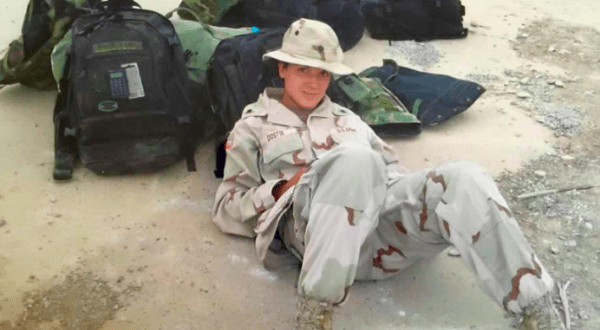How We Found Out explores recent reporting from Task & Purpose, answering questions about how we sourced our stories, what challenges we faced, and offers a behind-the-scenes look at how we cover issues impacting the military and veterans community.
Following a string of news reports on a private Facebook group called Marines United, where current and former Marines shared nude photos of their fellow service members, the Corps launched an internal investigation to determine if the incident was indicative of a larger problem facing the military’s smallest branch.
In December 2019, Task & Purpose published a feature story written by our editor in chief, Paul Szoldra, which drew from the internal review. In the article, Szoldra detailed the findings of that investigation, which included first-hand accounts from male and female Marines.
Task & Purpose spoke with Szoldra to discuss how he got his hands on the investigation, how he made sense of the more than 100 pages of anecdotes and personal testimony, and asked what, if anything, the Marine Corps may do to correct the problem.
This is the fourth installment in the recurring column How We Found Out.
James Clark: Paul, in early December you wrote a story on an internal investigation that the Marine Corps launched in the wake of the Marines United scandal. Do me a favor and give us a brief run-down of the incident that prompted this review, and what the review found.
Paul Szoldra:The story began in early March 2017, when journalist Thomas Brennan first revealed the existence of a Facebook group called Marines United. Brennan, a former Marine infantryman himself, wrote about what was in essence, a private group of about 30,000 past and present Marines where they were often sharing lewd photos of their fellow service members. We’re talking in many cases, nude photographs shared between consenting adults — think girlfriend and boyfriend and one is deployed, for example — then being made public to tens of thousands of others. We know it as “revenge porn” now, but at the time the Marine Corps really didn’t know the depth of the problem, which included not only sharing of nude photos, but some instances of cyber-stalking and widespread harassment of female service members.
It’s worth pointing out that from, my perspective, that a group like this existed wasn’t necessarily a surprise. When I was in the Marine Corps, in some units there would be a “hog board” where Marines would post pictures of ex-girlfriends who had wronged them. And all you have to do is read comments sections on stories mentioning female Marines and you’ll get a sense for how toxic the environment can be for female Marines.
So when the story broke, I remember Gen. Neller, then the commandant, holding a press conference. He looked almost beat up. He admitted that he didn’t even use social media. This just wasn’t in his purview. And in subsequent congressional hearings, he was flustered and admitted to lawmakers that he didn’t know all the answers. Which leads us to an internal review carried out by the Marine Corps, to actually find those answers, and get a sense for what the culture of the Corps was and if this was bigger than a Facebook group. It was.
JC: How did you end up getting your hands on the findings of this investigation?
PS: In early November, a source of mine emailed me with the report as an attachment. “I think you will find this interesting,” they said. I started reading and couldn’t believe what I had. Hundreds of pages of stories and frank conversations with active-duty Marines, all talking about negative perceptions of female Marines, how they viewed Marines United, how leadership was failing in addressing the issues. And these were comments from male and female Marines. The report was pretty damning.
I did a little bit more digging, and I ended up Googling the title of the report, which was anodyne: Marines’ Perspectives on Various Aspects of Marine Corps Organizational Culture.
That led me to the website of the Marine Corps Center for Advanced Operational Culture Learning, which had actually publicly posted it sometime in the months prior to me getting that email. I had no idea this thing existed, and it turns out, many in the Marine Corps didn’t either.
JC: The study was ordered in 2017, right? While reporting on this, did you find out why it didn’t come to light until now, or do you have any theories on why that might be the case?
PS: The study was officially published, at least internally, in March 2018. As far as why it didn’t come to light sooner, the Marine Corps is very sensitive about its public image. It doesn’t surprise me that the service might try to quietly release this report without putting out a press release. But I never got the sense that there was an active effort to suppress the findings or stop it from being released publicly. Still, a yearlong delay to a public release does raise some questions, and I honestly don’t know the answers.
JC: Now, can you explain to readers the value of getting your hands on internal investigations like this? What can you (and honestly, the Marine Corps in this case) glean from a review like this, that might not come out in, say, an external study conducted by RAND or another group?
PS:The thing that makes this report so valuable is that it is a snapshot in time of what Marines actually think and feel. There have been so many studies on culture in the Marine Corps, or ones that focus on female service members, but they were done by outsiders, or they were dry, statistic-laden reports. In this case, we had Marines telling their own stories of what it was like for them, and what kind of experiences they had with, or as, female Marines.
Just for some examples: A 2015 report from Rand found that women felt far more isolated in the Corps. And the Pentagon’s Office of People Analytics in 2018 noted that female Marines rated hostility toward them as “significantly higher” than their male counterparts, citing internal polling numbers.
Now here’s one anecdote I shared in my article:
One female Marine officer was introduced to this climate upon checking into her first unit, according to the culture report, when her commanding officer lectured her on sex. “Well, you’re one of three females here,” she recalled him saying. “We had an incident with the last female that was here. So, I’m not going to have this issue where you come in here — where I’m going to need to sit down with you in the future about you sleeping with anybody, am I?” When the female officer went home later that day and told her husband about the conversation, he was shocked. “Holy shit,” said her husband, who was also a Marine. “That’s something we would never have to deal with.”
Those earlier reports tell a story, but it’s incomplete. To hear the voices of these men and women on the page, paired with all this other research, paints a more full picture and helps people understand what it’s actually like. That’s far more powerful.
JC: Now, after you’ve sifted through hundreds of responses from this investigation, what do you do next? For readers who aren’t journalists, explain how you order and make sense of the things you’re reading, and who do you reach out to at the Marine Corps, and why?
PS:When I first dug into the report, I went through and took out certain anecdotes that I found interesting and copied them to a separate note-taking app on my computer, and organized them around themes. So I’d have certain quotes under the topic of “what it’s like being a female Marine,” or “diversity,” or “Marine Corps leadership,” and marked them with those page numbers. Then I was able to see a higher level picture of comments, and whether Marine A might back up Marine B with similar concerns. From there it was all a matter of telling an interesting story, and I ended up focusing on one female Marine in particular, who is introduced at the opening of the article, and then is brought back in at the end, to show that her career has been a microcosm for many female Marines.
As she told researchers, as a who was brand new to the Marine Corps, she was propositioned by her own sergeant almost as soon as she showed up to her unit. And then later, when she was a Staff Sergeant, she told the story of her being repeatedly harassed by a male Pfc. in front of senior leaders, who did nothing to help her or stop the behavior. As I wrote, the Corps didn’t change much in the years since. And that’s a real problem, because the Corps needs women onboard. They need to recruit and retain women in the service. But if these issues do not get addressed, it’s only a matter of time before parents are calling their member of Congress and asking why their daughter is serving their country and being harassed by their own colleagues. And it’s only a matter of time before more members of Congress start asking those same questions of Marine leaders.
JC: Task & Purpose, as well as many other military-focused news sites have reported on groups like MU over the years, many of which predated that scandal.
You mentioned earlier, and in the article, that the existence of Marines United group wasn’t a surprise to anyone who’d been paying attention. Why is it important to frame the MU scandal in this larger context, and with a long view?
PS:You’re right, this isn’t new. Task & Purpose first wrote about a Facebook page that was essentially dedicated to harassing female Marines back in 2014. The Corps didn’t do anything then. And frankly, I don’t get the sense the Corps is going to do much now. Sure, they’ve updated some regulations to remove gender-specific words, and they’ve kicked out Marines implicated in the Marines United scandal, but this report lays out a cultural problem. Culture can sometimes bubble up from the bottom, but in the Marine Corps, the commandant is the top. He’s basically god. Marines ponder what the commandant’s guidance is, and how they can carry it out.
And so far, Gen. Berger, the current CMC, hasn’t put out any kind of plan of action on this. He offered a token response to Military.com when asked about my reporting. It was basically, if you’re a Marine and you don’t like females, “go somewhere else.” I’d argue that if you’re the top dog of the Marine Corps, and you want to show you care about those women who wear the same uniform as you, you should be more forceful. It shouldn’t be “go somewhere else.” It should be, “I’m going to get rid of you and you will no longer be a Marine.”
Editor’s Note: You can always reach out to Task & Purpose journalists through our confidential tip line: tips@taskandpurpose.com. You can also say hi to the reporter on this story via Twitter: Paul Szoldra.

























